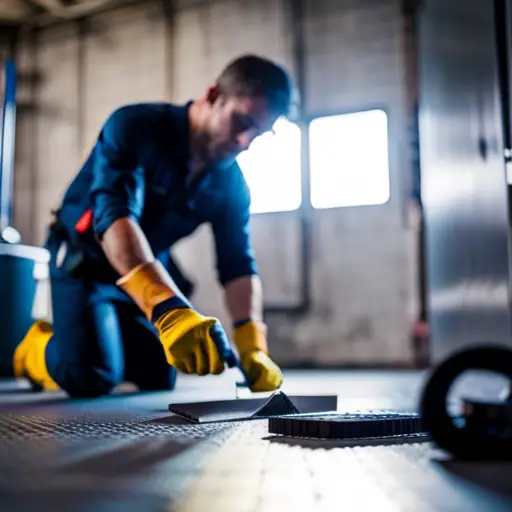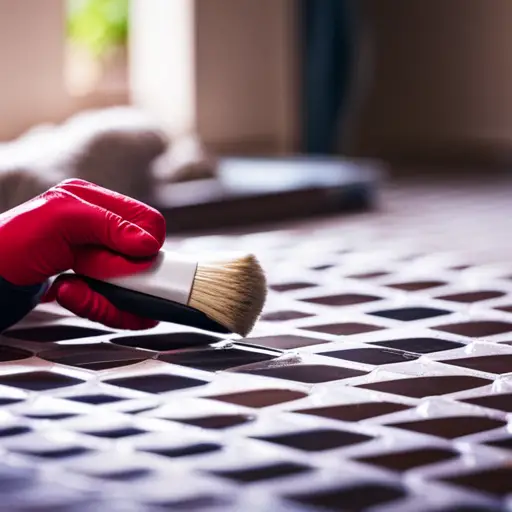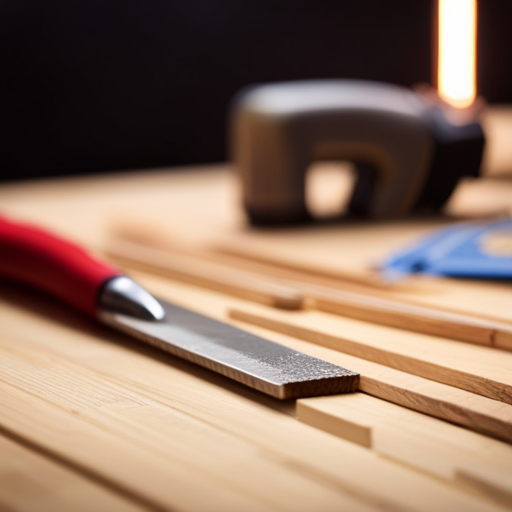Floor Restoration Vs. Replacement: Making the Right Choice

Like the threads of a well-worn tapestry, the decision between restoring or replacing a worn floor requires careful consideration. In this article, we delve into the intricate process of weighing the pros and cons of floor restoration versus replacement.
By examining factors such as cost, environmental impact, durability, and design options, we aim to provide a comprehensive guide to help you make the right choice for your space.
Assessing Floor Condition
Before deciding between floor restoration and replacement, it is essential to thoroughly assess the current condition of the floor. The first step in this process is conducting a comprehensive floor assessment. This involves identifying any visible signs of damage such as cracks, scratches, or discoloration. It is important to also check for structural issues such as uneven surfaces or loose floorboards. Additionally, assessing the level of wear and tear can help determine the overall condition of the floor.
Once the assessment is complete, it is crucial to explore the available repair options. For minor damages, simple solutions such as filling in cracks or sanding down scratches may be sufficient to restore the floor to its former glory. However, for more extensive damage or structural issues, it may be necessary to consider more intensive restoration techniques or even complete replacement. Understanding the full scope of repair options available is essential in making an informed decision regarding the most suitable course of action for the floor.
Cost Comparison
Assessing the overall cost comparison between floor restoration and replacement is crucial in making an informed decision about the most financially prudent course of action for the floor.
A comprehensive cost analysis is essential when evaluating whether to restore the existing floor or opt for a full replacement. Restoration costs typically involve the price of materials, labor, and any additional treatments required to revitalize the floor’s appearance and functionality.
On the other hand, replacement costs encompass the expense of new flooring materials, installation labor, and the removal and disposal of the existing floor. Budget considerations play a significant role in this decision-making process, as restoration may offer a more cost-effective solution in the short term, while replacement could potentially yield long-term savings by providing a more durable and low-maintenance flooring option.
It is imperative to weigh the upfront expenditures against the long-term benefits and maintenance costs associated with each choice. Additionally, the specific condition of the floor and the desired aesthetic and functional outcomes should be carefully evaluated to determine the most cost-effective and practical solution.
Environmental Impact
Carefully considering the environmental impact of floor restoration or replacement is essential for making an informed and sustainable decision. When weighing the options, it’s crucial to prioritize environmental sustainability.
One way to do this is by conducting a comprehensive carbon footprint analysis. This analysis will provide valuable insights into the environmental impact of both floor restoration and replacement, considering factors such as the extraction and manufacturing of new materials, transportation, installation, and waste generation.
Floor restoration often proves to be more environmentally sustainable than replacement. By refurbishing existing floors, the need for new materials is reduced, leading to lower carbon emissions and energy consumption. Additionally, restoration minimizes waste sent to landfills.
On the other hand, floor replacement typically involves the disposal of the existing flooring materials and the use of new resources, contributing to a higher environmental impact.
Time and Disruption
When considering whether to restore or replace a floor, there are several factors that need to be assessed.
One important factor to consider is the time frame for restoration. This involves looking at how long it will take to restore the floor to its original condition.
Another factor to consider is the disruption caused by replacement. This includes looking at how much of an impact replacing the floor will have on daily operations.
It is important to carefully evaluate these factors in order to make an informed decision regarding the best course of action for the flooring.
Restoration Time Frame
The restoration process for a floor can typically take several days to complete, depending on the size and condition of the area, causing minimal disruption to daily activities. This time frame allows for the restoration process to be efficiently managed within time constraints, ensuring that the project stays on schedule. The following table illustrates the restoration time frame for different types of flooring materials:
| Flooring Material | Restoration Time Frame |
|---|---|
| Hardwood | 3-5 days |
| Laminate | 2-4 days |
| Tile | 4-6 days |
Understanding the estimated time required for restoration can help in planning for minimal disruption to regular activities. Additionally, it allows for proper coordination with the restoration professionals to ensure a smooth and efficient process.
Disruption During Replacement
Comparing the restoration time frame for various flooring materials to the disruption caused by replacement, it becomes evident that replacement typically involves a more extensive timeframe and greater disturbance to regular activities.
Minimizing disruption during replacement is crucial to ensuring customer satisfaction. The process of replacing flooring can be disruptive, requiring the removal of furniture, appliances, and the temporary relocation of occupants. Additionally, there is often noise, dust, and odors associated with the removal and installation of new flooring.
This disruption can impact daily routines, work schedules, and general comfort within the space. Thus, it is essential for professionals to communicate effectively with customers, provide accurate timelines, and work efficiently to minimize the inconvenience caused by the replacement process, ultimately leading to improved customer satisfaction.
Impact on Daily Operations
During floor replacement, the extensive time frame and disruption to daily operations require careful consideration to minimize inconvenience and ensure customer satisfaction.
The impact on daily operations is significant, affecting daily productivity and workflow efficiency. The disruption caused by floor replacement can lead to temporary relocation of workspaces, hindering the normal flow of operations. This relocation can impact employee productivity and may require adjustments to maintain workflow efficiency.
Additionally, the noise and dust generated during replacement can further disrupt daily operations, potentially affecting customer experience.
Therefore, when deciding between floor restoration and replacement, evaluating the potential impact on daily operations is crucial. Minimizing disruptions and ensuring seamless workflow during the process is essential for maintaining productivity and customer satisfaction.
Long-Term Durability
When considering long-term durability, it is crucial to assess the expected lifespan and maintenance requirements of both floor restoration and replacement options. Here are key factors to consider:
-
Durability Assessment: Restoration typically prolongs the lifespan of the existing floor, addressing specific areas of wear and tear, while replacement ensures a brand-new, full lifespan.
-
Maintenance Considerations: Restored floors may require specialized maintenance to ensure longevity, whereas replacement floors often come with manufacturer warranties and require standard maintenance.
-
Cost Analysis: Restoration may initially be more cost-effective, but if the existing floor has extensive damage, replacement could be more economical in the long run.
-
Environmental Impact: Restoration reduces waste by reusing existing materials, making it a more sustainable option, while replacement often involves disposing of the old floor and introducing new materials.
Understanding the long-term durability implications of both restoration and replacement options is essential in making an informed decision. Once durability aspects are thoroughly evaluated, it is crucial to consider the impact of each option on the aesthetics and design of the space.
Aesthetics and Design Options
When considering floor restoration versus replacement, it’s important to evaluate the impact on aesthetics. Restoration can help preserve the original charm and character of the flooring, while replacement offers the opportunity for a fresh design and style.
Understanding the aesthetics and design options associated with each choice is essential in making the right decision for your space.
Aesthetics Impact Restoration
Restoring a floor’s aesthetics involves carefully considering various design options to enhance its visual appeal and overall appearance. When it comes to aesthetics impact restoration, it’s crucial to employ restoration techniques that align with modern trends and customer satisfaction.
Here are key factors to consider:
-
Material Selection: Opting for high-quality and visually appealing materials can significantly enhance the aesthetics of the restored floor.
-
Color and Pattern Choices: Utilizing modern color palettes and patterns can breathe new life into the floor’s appearance, catering to contemporary design preferences.
-
Surface Finish: Employing a suitable surface finish, such as matte or gloss, can influence the overall aesthetic and feel of the restored floor.
-
Customization Options: Offering customizable design elements allows for a personalized touch, ensuring customer satisfaction and a unique aesthetic appeal.
Considering these factors ensures that the restored floor meets modern aesthetic expectations, ultimately enhancing customer satisfaction and visual appeal.
This leads to a smooth transition into the subsequent section about ‘design flexibility with replacement.’
Design Flexibility With Replacement
Enhancing design flexibility and exploring new aesthetic options becomes crucial when considering floor replacement as a viable choice, thus ensuring alignment with modern trends and customer preferences. Replacement benefits include the ability to choose from a wide range of design options, allowing for customization according to specific aesthetic requirements.
Whether it’s hardwood, laminate, vinyl, or tile, replacement offers the opportunity to select from various textures, patterns, and colors, enabling a tailored approach to match or enhance the existing decor. This flexibility ensures that the new flooring seamlessly integrates with the overall design scheme, creating a cohesive and visually appealing space.
Furthermore, advancements in floor materials and technology provide innovative design possibilities, allowing for creative expression and adaptation to evolving interior styles. Ultimately, the design flexibility offered by floor replacement opens doors to endless aesthetic opportunities, meeting the diverse preferences of customers.
Frequently Asked Questions
Can I Restore a Floor That Has Been Damaged by Water or Fire?
Restoring a floor damaged by water or fire involves assessing the extent of the damage, identifying the restoration options, and considering factors such as cost, time, and feasibility. Water damage restoration and fire damage restoration are specialized processes requiring professional expertise.
Is There a Significant Price Difference Between Restoration and Replacement for High-End Flooring Materials Like Hardwood or Marble?
When considering high-end flooring materials like hardwood or marble, the price difference between restoration and replacement can be significant. However, restoration preserves the material’s suitability, requires professional expertise, and can provide cost-effective solutions.
How Does Floor Restoration Contribute to Reducing Carbon Footprint Compared to Replacement?
Floor restoration contributes to reducing the carbon footprint compared to replacement by minimizing waste and utilizing energy-efficient processes. By refurbishing existing materials, it conserves resources and reduces the environmental impact of manufacturing new flooring materials.
What Is the Average Time It Takes to Restore a Floor Compared to Replacing It, and How Much Disruption Can I Expect During the Process?
Restoring a floor typically takes less time than replacing it, with an average of 2-5 days for restoration compared to 1-2 weeks for replacement. Disruption during restoration is minimal, while replacement involves more extensive disruptions.
Are There Any Design Limitations When It Comes to Restoring a Floor, and What Options Are Available for Customizing the Look of a Restored Floor?
When restoring a floor, there are various customization options available to cater to design preferences. While some limitations may exist, innovative techniques and materials can often overcome these, allowing for a personalized and unique result.
Conclusion
Ultimately, the decision between floor restoration and replacement depends on various factors such as cost, environmental impact, time, durability, and design options. It is important to carefully assess the condition of the floor and consider the long-term implications of each choice.
One must weigh the financial and environmental costs against the aesthetic and durability benefits to make the right decision.
Like a carefully crafted piece of art, the choice between restoration and replacement can shape the overall ambiance and feel of a space.

Rubin Everest, a seasoned expert in the world of flooring, brings a wealth of knowledge and passion to the surface. As the mind behind ebbow.com, Rubin is dedicated to sharing insights on the latest trends, innovative solutions, and expert advice in the realm of flooring. Whether you’re seeking practical tips for installation or design inspiration, Rubin Everest is your go-to source for all things flooring-related, making your journey to the perfect floor an informed and enjoyable experience.





